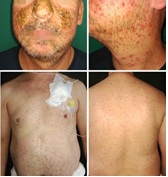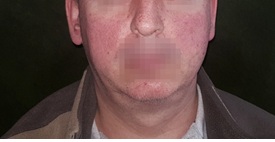Previous Issues Volume 5, Issue 1 - 2021
Severe Acneiform Eruption Secondary to Cetuximab Successfully Treated with Isotretinoin
Andrea Montes-Torres1*, Celia Camarero-Mulas2
1Department of Dermatology, Hospital Clínico Universitario Lozano Blesa, Zaragoza, Spain
2Department of Dermatology, Hospital General Universitario Gregorio Marañón, Madrid, Spain
*Corresponding Author: Andrea Montes-Torres, Department of Dermatology, Hospital Clinico Universitario Lozano Blesa, Avda, de San Juan Bosco, 15, 50009 Zaragoza, Spain, Tel: +34-91-5202433; Fax: +34-91-5202435; E-mail: [email protected].
Received Date: January 02, 2021
Published Date: March 02, 2021
Copyright: Montes-Torres A, et al. ©2021. This is an open-access article distributed under the terms of the Creative Commons Attribution License, which permits unrestricted use, distribution, and reproduction in any medium, provided the original author and source are credited.
Citation: Montes-Torres A, et al. Severe Acneiform Eruption Secondary to Cetuximab Successfully Treated with Isotretinoin. M J Derm. 05(1):15.
CASE PRESENTATION
Acneiform reactions are one of the most common and earliest cutaneous side-effects associated with the use of epidermal growth factor receptor (EGFR) inhibitors, widely used in the management of advanced-stage solid tumors such as cetuximab and panitumumab (anti-EGFR monoclonal antibodies), anderlotinib and gefitinib (EGFR tyrosine kinase inhibitors). A positive correlation has been demonstrated between the intensity of these cutaneous eruptions and both the tumor response to the antineoplastic therapy and overall survival [1,2]. However, their severity entails an important limiting factor for continued use of antineoplastic treatment and therefore [3], a successful cutaneous management is crucial. We report the case of a severe acneiform eruption in a patient with metastatic colorectal cancer treated with cetuximab and his good response to oral retinoids.
A 50-year-old man diagnosed with metastatic colorectal adenocarcinoma under cetuximab treatment was referred to our department because of a 2-week history of an acneiform eruption that had appeared one week after the first infusion of cetuximab. The patient had been diagnosed with colorectal carcinoma and synchronous hepatic metastases in September 2016 that was initially treated with surgery and polychemotherapy. One year later, he experienced an additional liver relapse and developed pulmonary metastases and cetuximab was then also initiated. Physical examination revealed an extensive monomorphic papulopustular eruption on the face, scalp, neck, trunk and proximal third of upper limbs. On the face, the bursting of the coalescent pustules gave way to the formation of large crusts (Figure 1). Because of the rash severity, cetuximab was interrupted and the patient was started on doxycycline, 100 mg twice daily, in association with topical clindamycin and zinc sulfate foments. Two weeks later, there was a moderate improvement of the skin lesions and cetuximab was restarted at a lower dose without discontinuing doxycycline. However, a marked worsening of skin lesions occurred during subsequent weeks and cetuximab had to be again interrupted. In order to continue cetuximab, isotretinoin 20 mg daily (0.3 mg /kg) was administered with a marked clinical response after six weeks of treatment (Figure 2). Isotretinoin was well tolerated and was administered for an additional seven weeks, when it had to be interrupted because of resection of hepatic metastases. No significant alterations in routine laboratory testing were observed.
Figure 1: Multiple papulopustular lesions and large crusts three weeks after starting cetuximab.
Figure 2: Significant clearing of inflammatory lesions with only erythematous macules remaining during isotretinoin treatment.
Cetuximab is a monoclonal antibody directed against EGFR, which is mainly used to treat head and neck cancer and tumors of the large intestine. Its use is associated in up to 80% of cases with the development of acneiform eruptions characterized by a dose-dependent papulopustular eruption localized on seborrheic areas that appears prematurely within 1-2 weeks after the onset of treatment [4]. There is generally good control with topical treatments and/or doxycycline and dose reductions and interruptions of the antineoplastic drug are not usually necessary. In fact, progressive improvement and stabilization of the skin eruption over weeks are usually observed [2,4]. However, 10% of patients may experience a more severe reaction [5] that may become refractory to the use of tetracyclines as inour case [1,2]. In these cases, isotretinoin should be considered an effective and safe alternative to be used, as it permits continuation of the antineoplastic treatment, a key point for cancer patients [3,6].
REFERENCES
- Chiang HC, Anadkat MJ. (2013). Isotretinoin for high-grade or refractory epidermal growth factor receptor inhibitor-related acneiform papulopustular eruptions. J Am AcadDermatol. 69:657-658.
- Vezzoli P, Marzano AV, Onida F, Alessi E, Galassi B, et al. (2008). Cetuximab-induced acneiform eruption and the response to isotretinoin. Acta DermVenereol. 88:84-86.
- Andrews ED, Garg N, Patel AB. (2020). A retrospective chart review on oral retinoids as a treatment for epidermal growth factor receptor inhibitor- and mitogen-activated protein kinase kinase inhibitor-induced acneiform eruptions. J Am Acad Dermatol. 82:998-1000.
- Requena C, Llombart B, Sanmartín O. (2012). Acneiform eruptions induced by epidermal growth factor receptor inhibitors: treatment with oral isotretinoin. Cutis. 90:77-80.
- Price TJ, Peeters M, Kim TW, Li J, Cascinu S, et al. (2015). Final resultsfrom ASPECCT: Randomized phase 3 non-inferiority study of panitumumab (pmab) vs cetuximab (cmab) in chemorefractory wild-type (WT) KRAS exon 2 metastatic colorectal cancer (mCRC). J ClinOncol. 33(suppl):3586a.
- Costello CM, Hill HE, Brumfiel CM, Yang YW, Swanson D. (2021). Choosing Between Isotretinoin and Acitretin for Epidermal Growth Factor Receptor Inhibitor and Small Molecule Tyrosine Kinase Inhibitor Acneiform Eruptions. J Am Acad Dermatol. 84(3):840-841. doi: 10.1016/j.jaad.2020.09.090.

